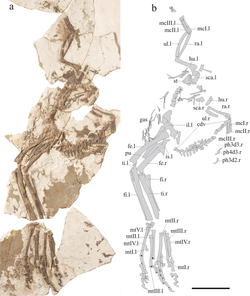| Xingtianosaurus Temporal range: Early Cretaceous, | |
|---|---|
 | |
| Holotype specimen, photograph (left) and line drawing (right) | |
| Scientific classification | |
| Domain: | Eukaryota |
| Kingdom: | Animalia |
| Phylum: | Chordata |
| Clade: | Dinosauria |
| Clade: | Saurischia |
| Clade: | Theropoda |
| Family: | † Caudipteridae |
| Genus: | † Xingtianosaurus Qiu et al., 2019 |
| Type species | |
| †Xingtianosaurus ganqi Qiu et al., 2019 | |
Xingtianosaurus is an extinct genus of oviraptorosaurian theropod dinosaur that lived in what is now China during the Early Cretaceous. The type and only species, X. ganqi, was named and described in 2019. [1] It was placed in the Caudipteridae, alongside Caudipteryx and Similicaudipteryx . [2] [3] [4]

